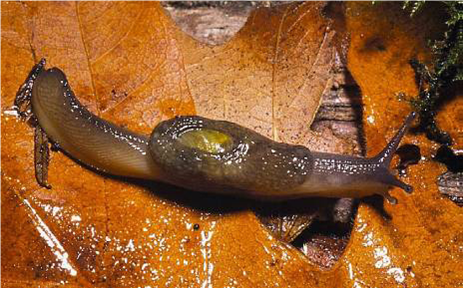thought this might be worth a discussion since it somehow came up in our interview with Snohomish County recently – and we won the IDIQ contract! So, ok, this species in particular wasn’t mentioned – but the subject of jumping slugs was breached – so here we are.
First off – jumping slugs don’t quite jump, but rather corkscrew themselves up and expand quickly, springing off their perch to avoid predators. On a horizontal surface they appear to wriggle like a landed fish. Slugs, along with animals such as snails and clams are a mollusk – slugs are in the Class Gastropoda – which means stomach-foot – which is a bit of a misnomer. While they appear to us to be crawling along on their “belly”, their stomach and the rest of the digestive system is on their back, or dorsal side. The genus Hemphillia honors the American malacologist (studies mollusks) Henry Hemphill (1830-1914) – really quite the honor to have a whole genus of slugs named after you. Dromedarius – roughly translated from Latin, means swift, or runner in Greek. If you squint and use some imagination I suppose – and the description is relative to other slugs. It also has a distinct hump on its back where the internal organs are housed – so a reference to the one-humped (dromedary) camel as well.
This slug was relatively recently discovered here in the Pacific Northwest in 1972. Its range extends from southern B.C. through western Washington, with unconfirmed sightings from Oregon. The slug grows to about 2.5 inches with a gray mantle and foot with cream-colored mottling on the sides. The tail is compressed laterally with a distinct keel. It’s thought that it takes about two years to reach maturity. This slug is usually found on or under woody debris. 50-60 eggs are laid in the autumn in small clusters. Predators of slugs include birds, amphibians, some beetles, and small mammals.
This slug is secretive and primarily nocturnal and, like other slugs, is photophobic (they don’t like direct light). In general, not much is known of the life history of these critters. The dromedary jumping slug is associated with mature and old-growth temperate coniferous forests. All records are from forests with trees older than 80 years. Because of the steady loss of old-growth forest there has been an increasing concern regarding jumping slugs and both the U.S. and Canadian land management agencies have developed long-term conservation plans for this group of species. But because the focus on this group of slugs is relatively recent, there are no statistics regarding population trends.
Populations appear to be able to survive at low densities – in studies in Canada only 1 or 2 individuals were found during searches that lasted 40-540 minutes per person. Let me tell you – that is a lot of crawling around on hands and knees rummaging around for these tiny guys. These slugs prefer areas with lots of coarse woody debris thought to provide suitable microhabitats for shelter from predators and environmental fluctuations. Gastropods, in general, contribute to the breakdown of organic matter in the forest and the formation of soils.
Dehydration is a constant threat and the oft-quoted gastropod verse applies: “…the raindrops knock on the door, and the snail comes out. Hydration follows after, when it has eaten and drunk, and then perhaps make a secondary contribution to the great rise in metabolic rate”. Oh, what a focused and concise life!!
All slugs deposit a dilute mucous trail and thus are constantly losing water this way. Within two hours active slugs (well as active as they are) can lose 30-40% of their body weight. Thus, habitat selectivity and water conservation are key factors for these small animals.
And here’s the dromedary jumping slug in action: https://www.youtube.com/watch?v=TVj991ExTwQ
So, for that next hike in the old growth when you have stopped for lunch you might want to scrape around a mid in some moist areas – never know what you might find.
I’m in the field all week next week so the OOTW will have a hiatus.
